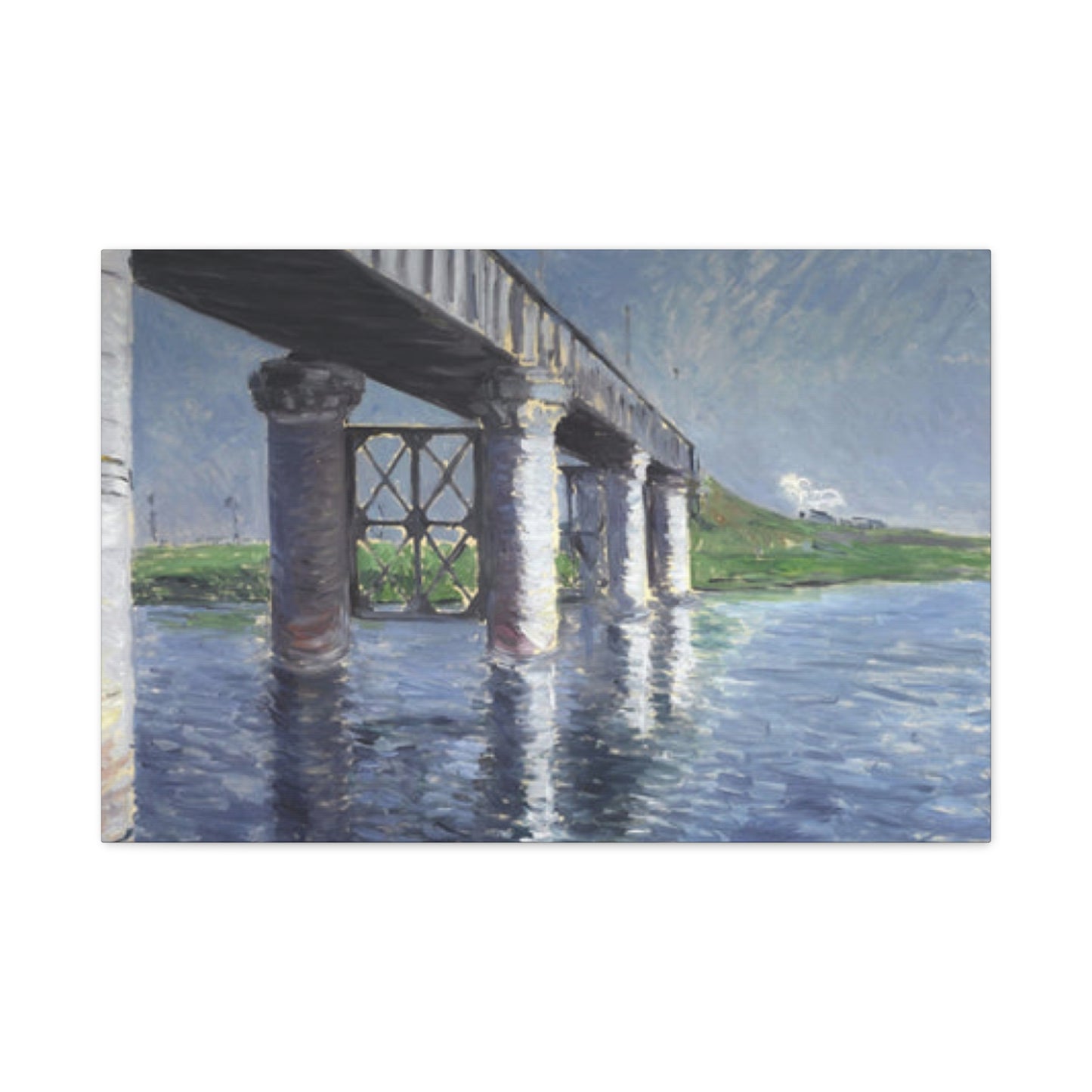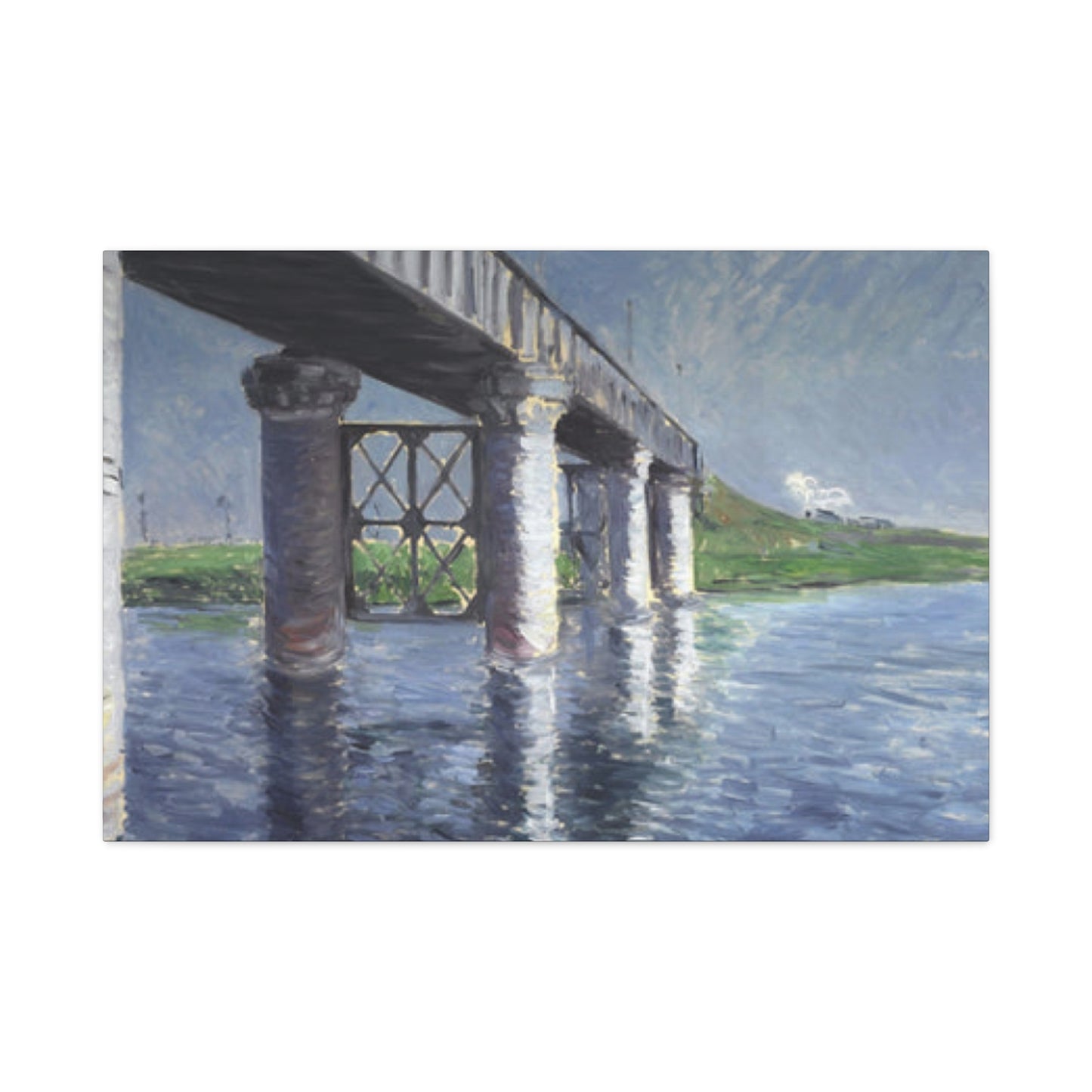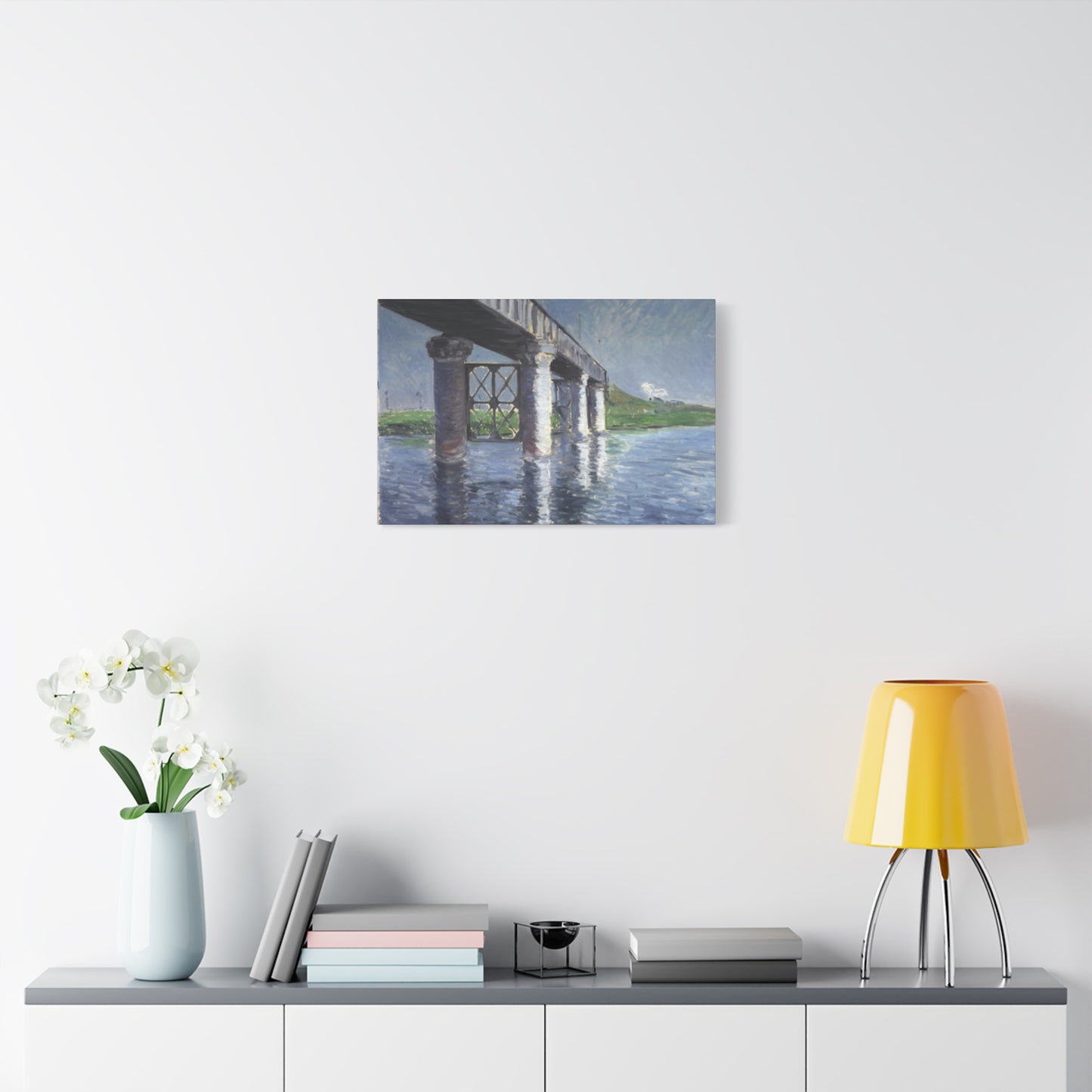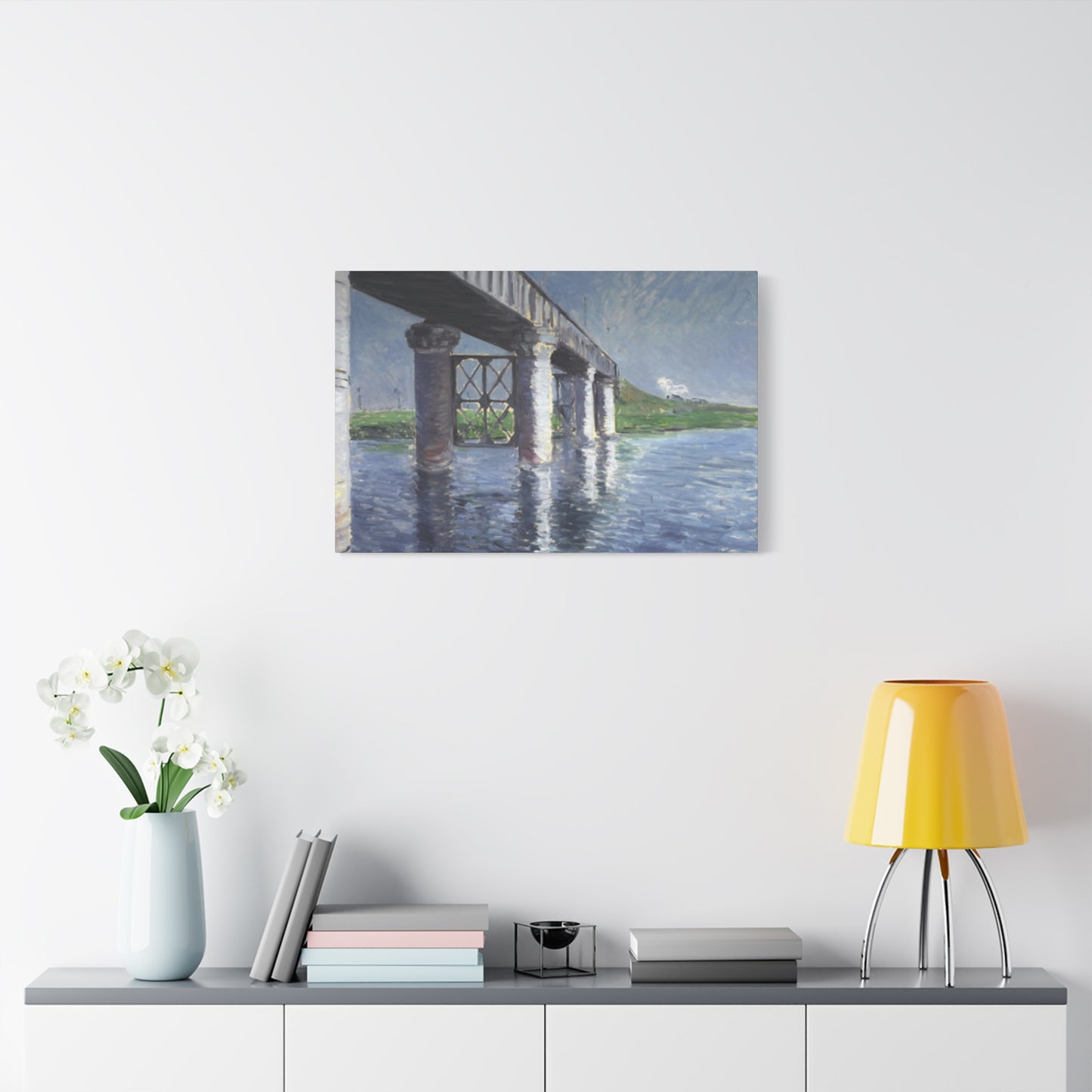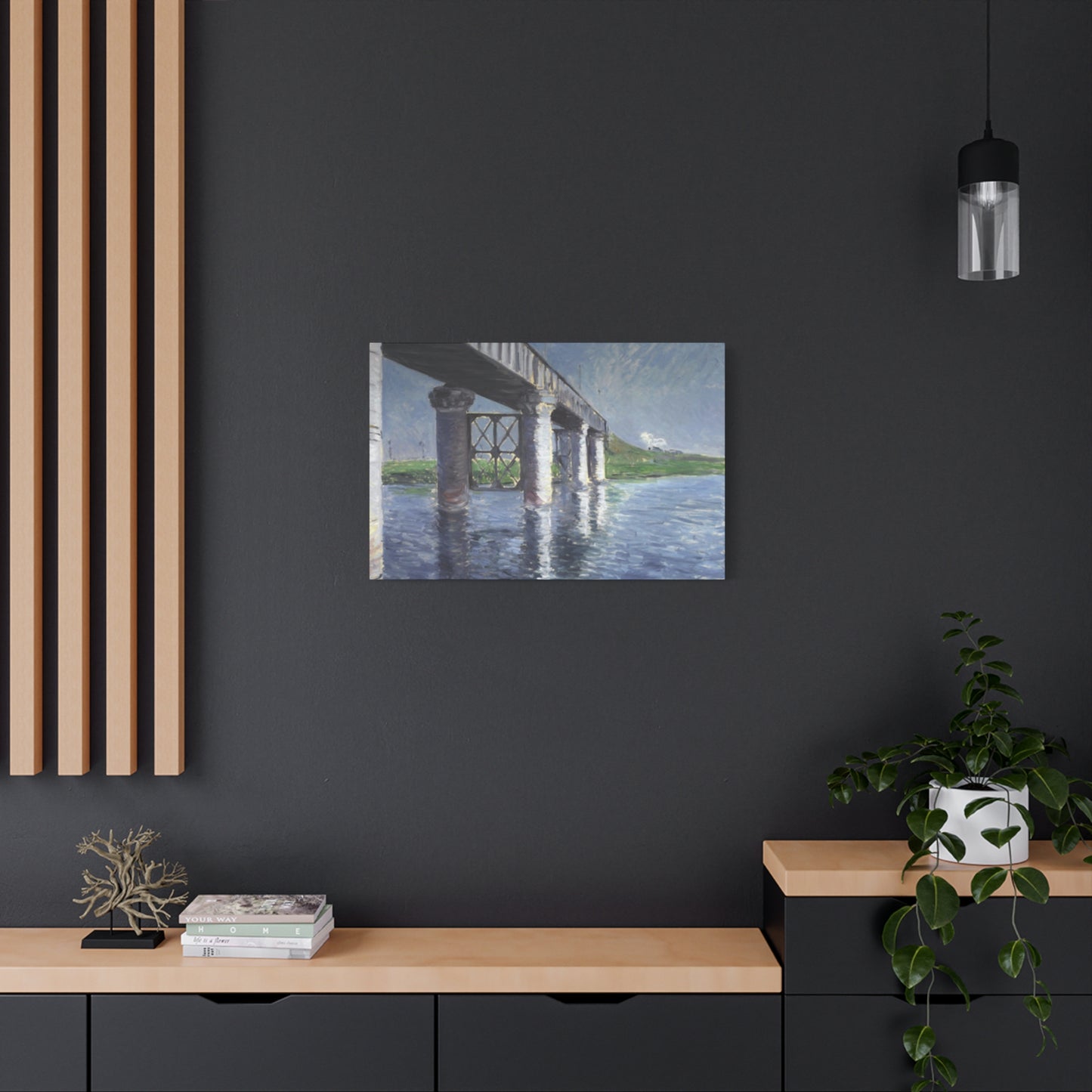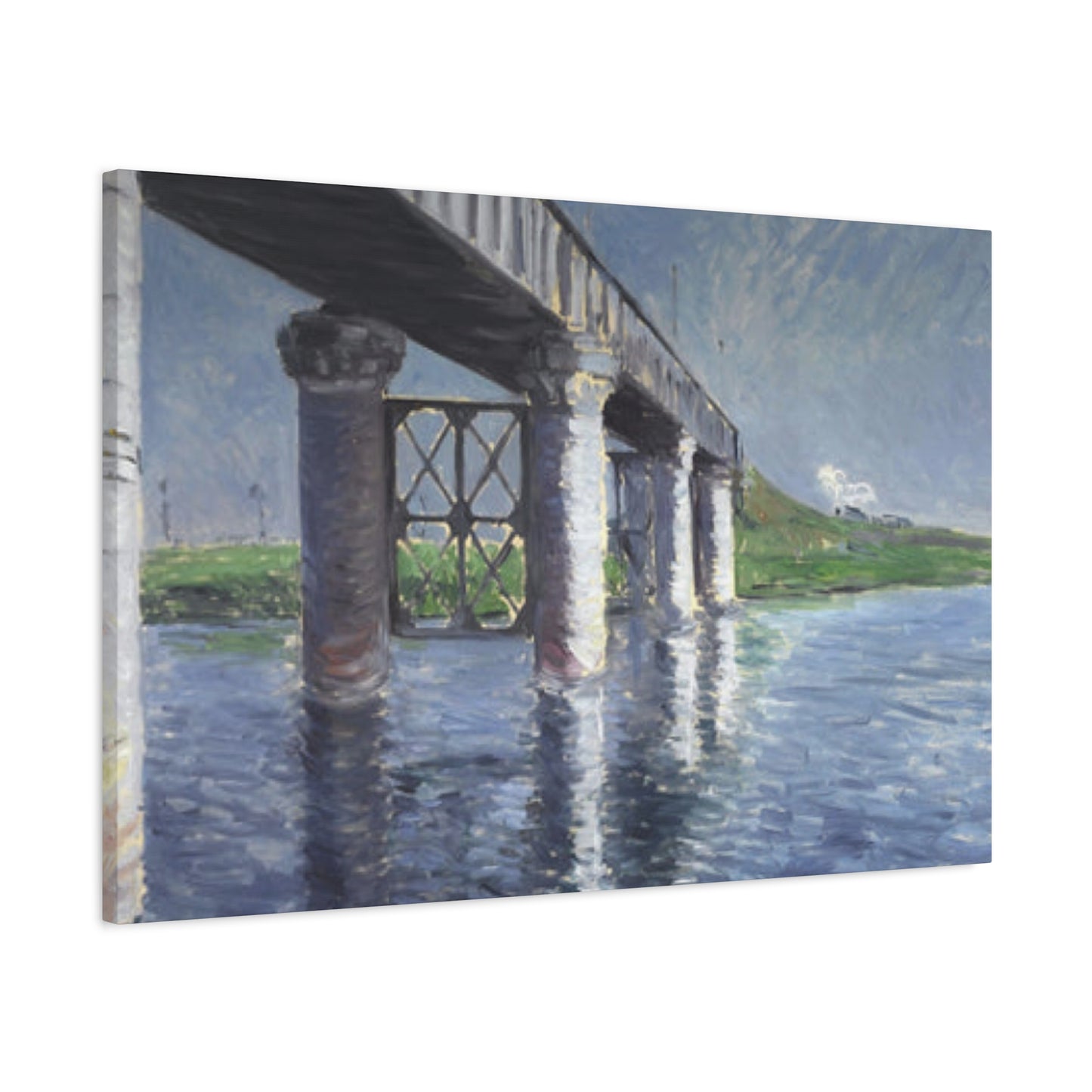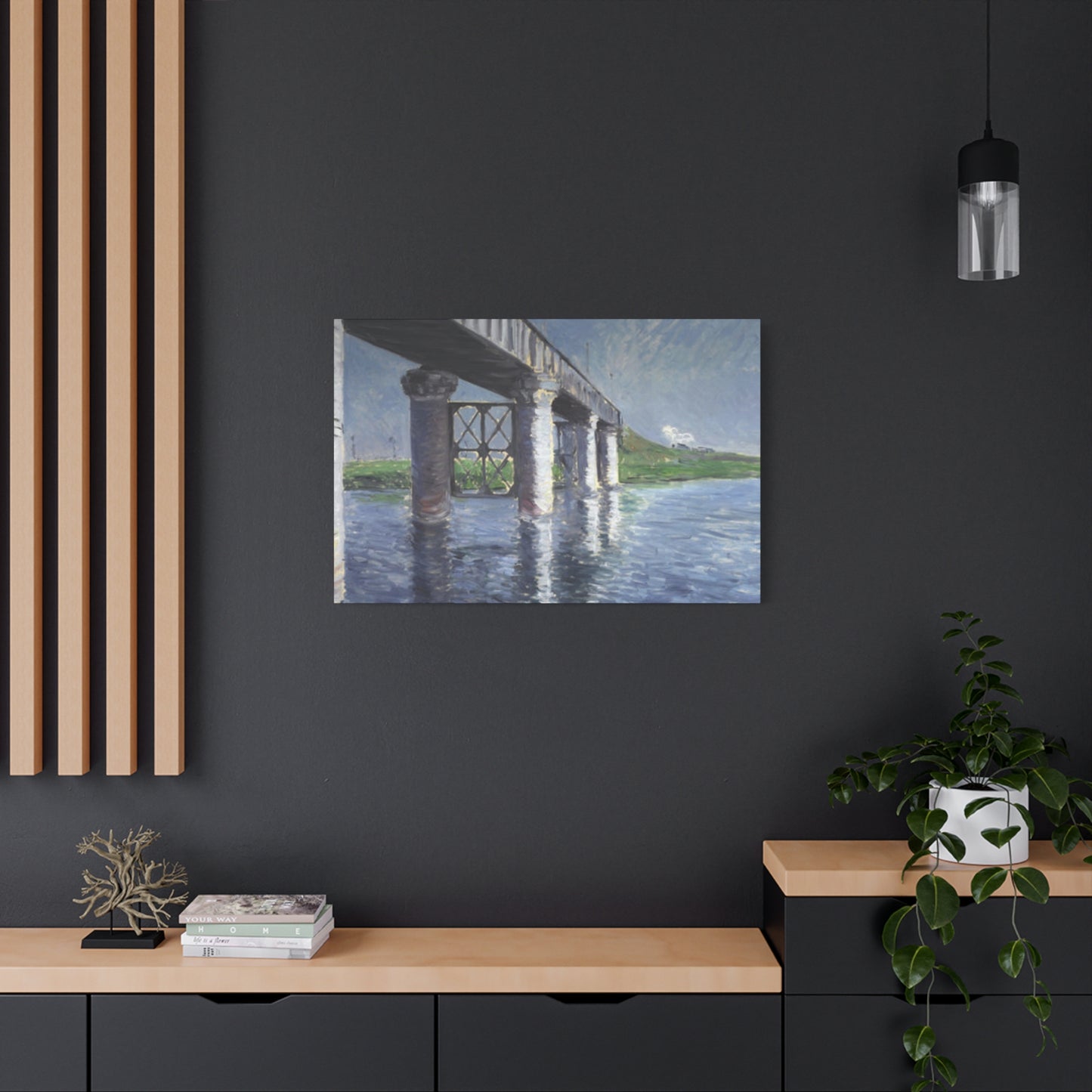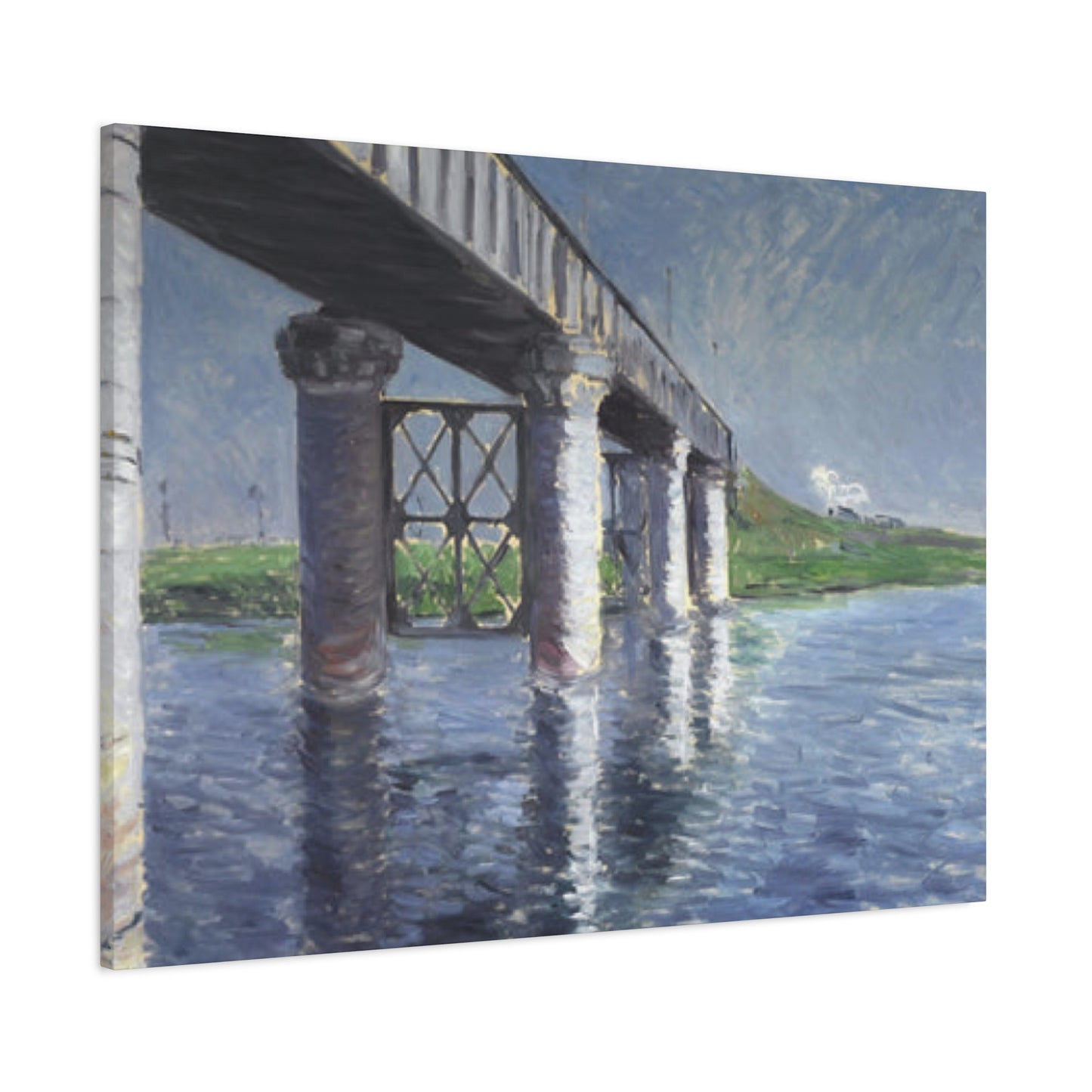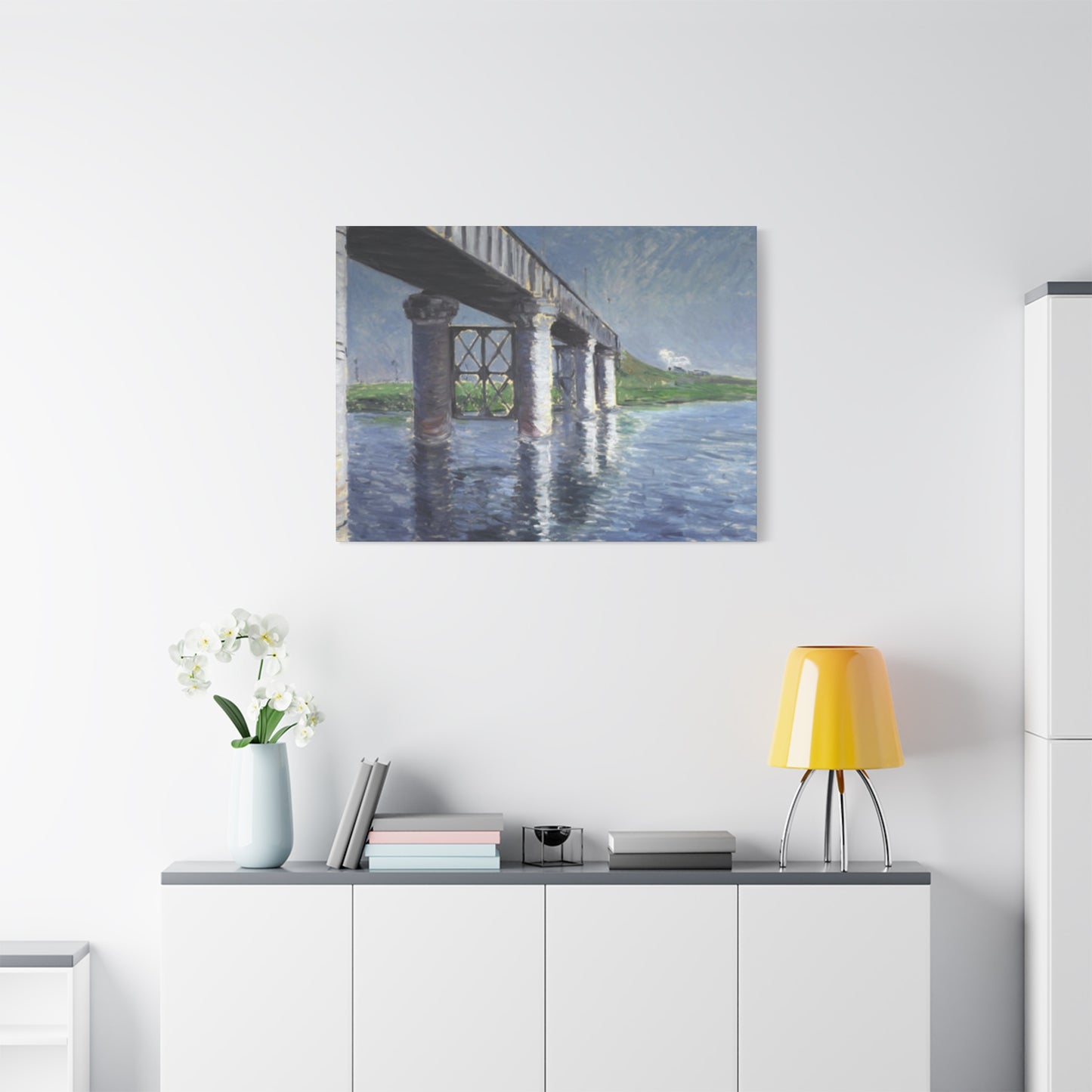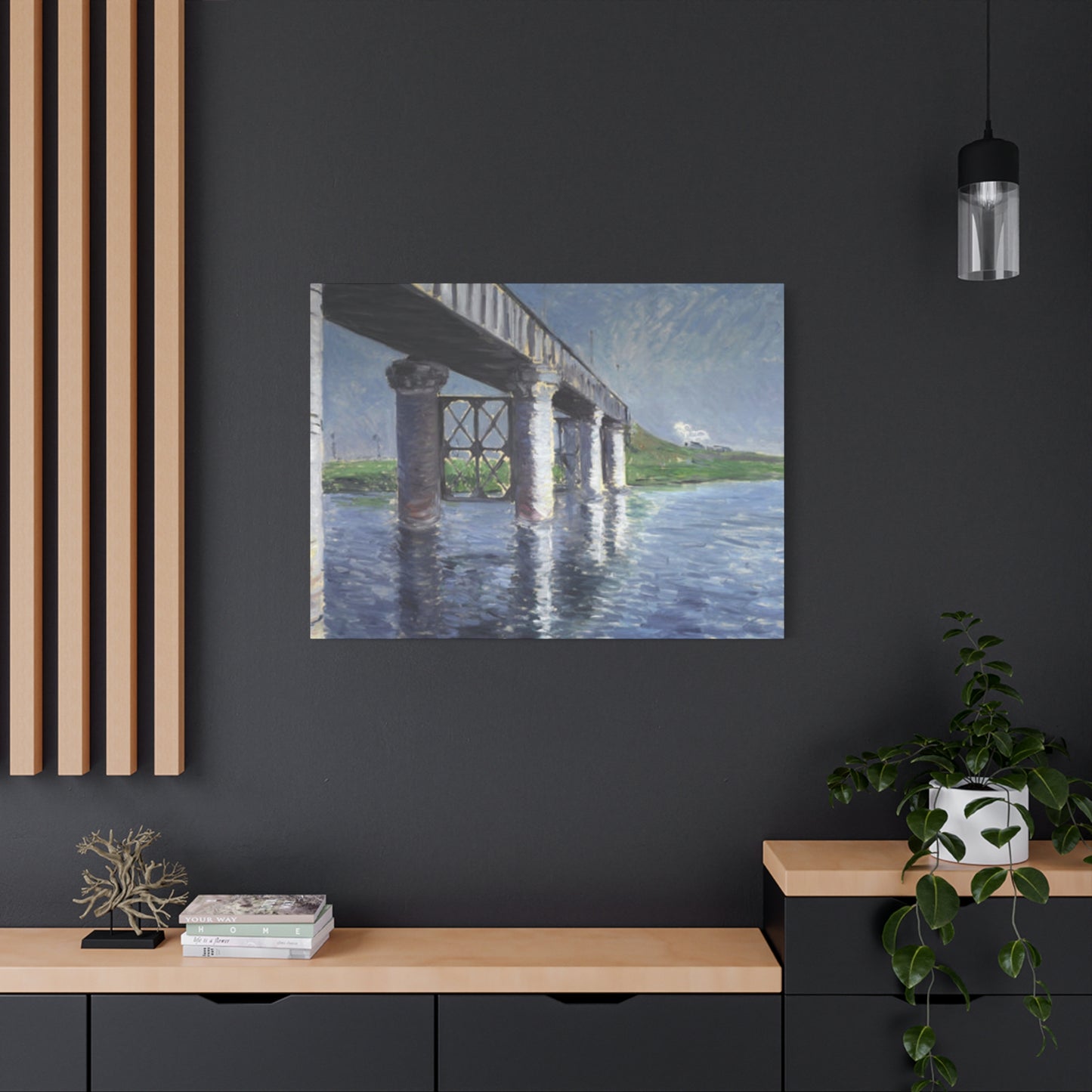Masterful Metal Bridge Wall Art by Gustav Perfect for Contemporary Homes
The artistic representation of Gustav metal bridges has evolved significantly over the past century, establishing itself as a cornerstone of contemporary wall art collections. These magnificent structural marvels have captured the imagination of artists worldwide, transforming cold steel and engineering precision into breathtaking visual masterpieces that grace homes and commercial establishments alike.
Gustav bridge paintings originated from the industrial revolution era when engineers and architects began recognizing the aesthetic potential of functional structures. The interplay between form and function became a central theme in artistic expression, with metal bridges serving as perfect subjects for exploring the harmony between human innovation and natural beauty. Early artists were fascinated by the geometric patterns, shadows, and reflections created by these architectural giants.
The development of canvas printing technology revolutionized how these artistic interpretations reached consumers. No longer confined to original oil paintings or watercolors, Gustav metal bridge artwork became accessible through high-quality reproductions that maintained the integrity and visual impact of the original pieces. This democratization of art allowed homeowners to incorporate professional-grade artwork into their living environments without the prohibitive costs associated with original paintings.
Contemporary artists have embraced various techniques to capture the essence of Gustav bridges, from photorealistic renderings to abstract interpretations that emphasize color, texture, and emotional resonance. The versatility of canvas as a medium allows for detailed reproduction of intricate metalwork while preserving the dramatic lighting and atmospheric conditions that make these structures so compelling as artistic subjects.
The evolution of printing techniques has further enhanced the appeal of Gustav bridge wall art. Modern canvas prints utilize advanced pigmentation systems and protective coatings that ensure longevity and color fidelity, making these pieces suitable for both residential and commercial applications. The durability of contemporary canvas prints means that homeowners can enjoy these artistic representations for decades without significant deterioration.
Artistic Techniques and Styles in Gustav Bridge Canvas Prints
The artistic rendering of Gustav metal bridges encompasses a diverse range of techniques and stylistic approaches that cater to varying aesthetic preferences and home decor themes. Artists employ multiple methodologies to capture the essence of these structural marvels, each bringing unique perspectives and emotional depth to their interpretations.
Photorealistic techniques dominate much of the Gustav bridge artwork market, utilizing precise detail work and careful attention to lighting conditions to create images that appear almost photographic in their accuracy. These pieces often showcase the intricate lattice work of metal trusses, the play of sunlight through structural elements, and the reflection of bridges in surrounding water bodies. The technical precision required for such artwork demands extensive skill in perspective, proportion, and atmospheric rendering.
Impressionistic approaches to Gustav bridge painting offer a different aesthetic experience, focusing on color relationships, brushwork texture, and emotional interpretation rather than strict adherence to physical accuracy. These pieces often emphasize the mood and atmosphere surrounding the bridge, using loose brushstrokes and vibrant color palettes to evoke feelings of movement, progress, and human achievement. The impressionistic style allows artists to capture the dynamic energy of these structures while maintaining artistic freedom in their interpretation.
Abstract representations of Gustav bridges push the boundaries of traditional landscape painting, reducing structural elements to their essential geometric forms and exploring color relationships that may not exist in reality. These pieces often focus on the rhythm and pattern created by repeated structural elements, transforming the bridge into a study of line, form, and composition. Abstract Gustav bridge artwork appeals to collectors who appreciate modern art aesthetics and prefer pieces that complement contemporary home decor themes.
Mixed media approaches combine traditional painting techniques with photographic elements, digital manipulation, and sometimes three-dimensional components to create unique interpretations of Gustav bridge subjects. These innovative pieces often incorporate textural elements that mirror the roughness of weathered steel or the smoothness of painted surfaces, adding tactile interest to the visual experience.
The choice of color palette significantly influences the emotional impact of Gustav bridge artwork. Warm earth tones and golden lighting create inviting, nostalgic atmospheres, while cool blues and grays emphasize the industrial nature of these structures. Some artists deliberately manipulate color to create dramatic contrasts or to harmonize the artwork with specific interior design schemes.
Canvas Print Quality and Manufacturing Considerations
The production of high-quality Gustav metal bridge canvas prints involves sophisticated manufacturing processes that ensure both visual fidelity and long-term durability. Understanding these quality factors helps consumers make informed decisions when selecting artwork for their homes or commercial establishments.
Contemporary canvas printing utilizes advanced inkjet technology with pigment-based inks that offer superior color accuracy and fade resistance compared to traditional dye-based alternatives. The pigment particles are larger and more stable, providing better adhesion to the canvas fibers and enhanced resistance to environmental factors such as ultraviolet light, humidity, and temperature fluctuations. This technology ensures that Gustav bridge artwork maintains its visual impact for many years under normal display conditions.
The canvas substrate itself plays a crucial role in the final quality of the artwork. Premium cotton canvas offers superior texture and absorption characteristics compared to synthetic alternatives, providing better ink adhesion and more authentic artistic appearance. The weight and weave of the canvas affect both the visual texture and the structural integrity of the finished piece. Heavier canvas weights provide better dimensional stability and are less prone to sagging or warping over time.
Stretching and mounting procedures significantly impact the professional appearance and longevity of Gustav bridge canvas prints. Proper stretching ensures that the canvas surface remains taut and free from wrinkles or distortions that could detract from the artwork's visual impact. The stretcher frame construction, typically made from kiln-dried wood, must provide adequate support without introducing acidic compounds that could cause deterioration over time.
Protective coatings applied to finished canvas prints serve multiple functions, including UV protection, moisture resistance, and surface protection against dust and minor abrasions. These coatings must be carefully formulated to provide protection without altering the color balance or surface texture of the artwork. Some coatings also provide anti-reflective properties that enhance viewing under various lighting conditions.
Quality control measures throughout the manufacturing process ensure consistent results across different production runs. Color calibration systems maintain accurate reproduction of the original artwork, while inspection procedures identify and eliminate pieces that fail to meet established quality standards. Professional-grade Gustav bridge canvas prints undergo multiple quality checkpoints before reaching consumers.
The packaging and shipping of canvas prints require specialized techniques to prevent damage during transit. Protective wrapping materials, rigid backing boards, and moisture barriers protect the artwork from environmental hazards and physical damage. Proper packaging ensures that consumers receive their Gustav bridge artwork in pristine condition, ready for immediate display.
Home Decor Integration and Placement Strategies
Successfully incorporating Gustav metal bridge canvas prints into home decor requires careful consideration of multiple factors including room function, lighting conditions, existing decor elements, and personal aesthetic preferences. The dramatic nature of bridge artwork makes it particularly suitable for creating focal points and establishing design themes throughout residential environments.
Living room placement of Gustav bridge artwork often serves as the primary focal point, typically positioned above sofas, fireplaces, or entertainment centers. The horizontal orientation of most bridge compositions complements the linear nature of these furniture arrangements while providing visual balance to the room's proportions. Large-scale pieces work effectively in spacious living areas, while smaller prints can be grouped to create gallery wall arrangements that maintain visual coherence.
Dining room applications benefit from the sophisticated atmosphere that Gustav bridge artwork can provide. The industrial elegance of metal bridge subjects complements both traditional and contemporary dining furniture, creating conversation pieces that enhance the social aspects of dining experiences. The positioning should consider viewing angles from various seating positions around the dining table while avoiding locations where food service might pose risks to the artwork.
Bedroom integration requires sensitivity to the room's restful function while capitalizing on the romantic and inspiring qualities that bridge artwork can provide. Gustav metal bridge prints with softer color palettes and peaceful atmospheric conditions work well in bedroom environments, positioned where they can be appreciated without overwhelming the room's tranquil character. The artwork should complement rather than compete with other bedroom elements such as bedding, window treatments, and furniture finishes.
Office and study environments benefit from the inspiring and motivational qualities of bridge artwork, which symbolizes connection, progress, and human achievement. The architectural precision and engineering elegance of Gustav bridges can enhance the professional atmosphere while providing visual interest that reduces the sterile appearance of purely functional work areas. Proper positioning ensures that the artwork provides inspiration without creating distractions during focused work activities.
Hallway and transitional areas offer excellent opportunities for Gustav bridge artwork, where the sense of passage and connection inherent in bridge imagery reinforces the functional nature of these architectural areas. Long horizontal pieces work particularly well in corridor applications, while vertical compositions can enhance the height of stairway walls or narrow transitional areas.
Lighting considerations significantly affect the visual impact and preservation of Gustav bridge canvas prints. Natural light can enhance the artwork's appearance during daylight hours but requires careful management to prevent UV damage and glare issues. Artificial lighting systems should provide adequate illumination without creating hot spots or reflections that interfere with viewing. Track lighting, picture lights, and strategically placed lamps can dramatically enhance the artwork's visual impact while maintaining proper conservation conditions.
Size Selection and Proportional Considerations
Choosing the appropriate size for Gustav metal bridge canvas prints involves complex considerations that balance visual impact, room proportions, furniture relationships, and budget constraints. Understanding these relationships ensures that the artwork enhances rather than overwhelms the intended environment while providing optimal visual satisfaction.
Wall area calculations form the foundation of appropriate size selection, with professional designers typically recommending that artwork occupy between sixty to seventy-five percent of the available wall space above furniture pieces. This proportion creates visual balance while allowing the artwork to serve as an effective focal point without appearing cramped or lost on expansive wall surfaces. Gustav bridge prints, with their typically horizontal orientations, work particularly well within these proportional guidelines.
Furniture relationships significantly influence size requirements, with sofa-mounted artwork typically ranging from forty-eight to seventy-two inches in width depending on the furniture dimensions. The artwork should extend beyond the sofa arms while maintaining reasonable margins that prevent the composition from appearing crowded. Dining room applications over sideboards or buffets follow similar proportional relationships, though the viewing distance may allow for slightly larger pieces.
Ceiling height affects both the maximum practical size and the optimal positioning of Gustav bridge artwork. Standard eight-foot ceilings typically accommodate pieces up to thirty-six inches in height when properly positioned above furniture, while higher ceilings allow for more generous proportions and greater flexibility in placement options. The artwork should maintain visual connection with furniture elements while taking advantage of available vertical dimensions.
Multiple piece arrangements offer alternatives to single large prints, allowing for customized compositions that fit specific wall dimensions and design requirements. Triptych arrangements of Gustav bridge artwork can create dramatic impact while accommodating furniture groupings and architectural features that might constrain single-piece installations. The spacing between multiple pieces requires careful consideration to maintain visual cohesion while allowing each element to contribute to the overall composition.
Room function influences size selection through considerations of viewing distance and frequency of use. Areas designed for close inspection, such as reading nooks or study areas, benefit from smaller pieces with fine detail work that rewards careful examination. Conversely, areas designed for general social interaction require larger pieces with bold compositions that remain visually effective from various distances and viewing angles.
Budget considerations often constrain size selection, as larger canvas prints require more materials and manufacturing resources. However, the visual impact of appropriately sized artwork often justifies the additional investment compared to undersized pieces that fail to achieve their decorative potential. Strategic selection of key areas for larger pieces while using smaller complementary artwork elsewhere can optimize both budget allocation and visual impact.
Custom sizing options available from many manufacturers allow for precise dimensional matching to specific architectural requirements. This flexibility enables homeowners to achieve optimal proportional relationships while accommodating unique furniture arrangements or architectural features that standard sizes might not address effectively.
Color Psychology and Atmospheric Effects
The color composition of Gustav metal bridge canvas prints profoundly influences the psychological atmosphere and emotional response within residential and commercial environments. Understanding these color relationships enables informed selection that aligns with intended mood creation and existing decor harmonies while maximizing the artwork's positive impact on occupants and visitors.
Warm color palettes featuring golden yellows, russet oranges, and deep reds create inviting and energetic atmospheres that complement social areas such as living rooms, dining rooms, and family gathering areas. These colors evoke feelings of warmth, comfort, and human connection, making bridge artwork with sunset or sunrise lighting particularly effective in areas designed for relaxation and social interaction. The industrial strength of metal bridge subjects balanced with warm atmospheric lighting creates compelling contrasts that add visual interest without overwhelming the environment.
Cool color schemes dominated by blues, grays, and silvery tones emphasize the technological and architectural aspects of Gustav bridge subjects while creating calming and contemplative atmospheres. These palettes work effectively in professional environments, bedrooms, and study areas where reduced stimulation and enhanced focus are desired. The inherent coolness of metal bridge materials harmonizes naturally with these color choices, creating cohesive compositions that feel authentic and balanced.
Monochromatic approaches utilizing various shades and tints of single colors create sophisticated and unified compositions that integrate easily with existing decor while maintaining visual interest through tonal variations and textural contrasts. Black and white Gustav bridge prints offer timeless elegance that transcends decorative trends while emphasizing the structural and geometric qualities of the bridge subjects. These neutral approaches provide flexibility for future decor changes while maintaining their visual effectiveness.
Contrasting color relationships create dynamic visual tension that energizes environments and draws attention to the artwork. Complementary color combinations, such as warm oranges against cool blues or vibrant reds against deep greens, create vibrant compositions that serve as effective focal points. However, high contrast approaches require careful integration with existing room colors to avoid creating visual conflicts that detract from the overall design harmony.
Atmospheric effects within Gustav bridge artwork significantly influence the emotional response and environmental integration of the pieces. Misty morning scenes create peaceful and contemplative moods, while dramatic storm lighting evokes feelings of power and excitement. Clear daylight compositions emphasize the precision and craftsmanship of the bridge construction, while twilight scenes add romance and mystery to the industrial subjects.
Seasonal color variations allow homeowners to select Gustav bridge artwork that harmonizes with regional climate patterns and personal seasonal preferences. Spring compositions featuring fresh greens and soft pastels complement renewal themes, while autumn palettes with rich gold and burgundy tones create cozy atmospheres during cooler months. Winter scenes with stark contrasts and crystalline clarity offer different emotional experiences that some collectors prefer.
The interaction between artwork colors and artificial lighting systems requires consideration during selection and installation processes. Incandescent lighting tends to warm color temperatures while fluorescent lighting may cool them, affecting the perceived color balance and emotional impact of the artwork. LED lighting systems with adjustable color temperatures offer flexibility for optimizing the artwork's appearance under various conditions.
Maintenance and Preservation Techniques
Proper maintenance and preservation of Gustav metal bridge canvas prints ensures long-term visual quality and protects the investment value of these artistic pieces. Understanding appropriate care techniques and environmental management practices helps homeowners maintain their artwork collections in pristine condition for decades of enjoyment.
Environmental control represents the most critical aspect of canvas print preservation, with temperature and humidity fluctuations posing significant threats to both the canvas substrate and the printed image. Ideal conditions maintain temperatures between sixty-five and seventy-five degrees Fahrenheit with relative humidity levels between forty-five and fifty-five percent. Rapid fluctuations in either parameter can cause expansion and contraction cycles that stress the canvas fibers and potentially cause cracking or delamination of the printed surface.
Direct sunlight exposure presents one of the most significant threats to canvas print longevity, with ultraviolet radiation causing gradual fading and color shifts that permanently damage the artwork. Gustav bridge prints should be positioned away from windows receiving direct sunlight, or protective UV-filtering glazing should be installed to reduce harmful radiation exposure. Even indirect sunlight exposure should be minimized during peak intensity periods to maximize color preservation.
Dust accumulation affects both the visual appearance and long-term preservation of canvas prints, with particulate matter potentially embedding in the canvas texture and creating permanent staining over time. Regular gentle cleaning using soft-bristled brushes or low-suction vacuum cleaners with brush attachments removes surface dust without damaging the canvas or printed surface. Cleaning should always proceed from top to bottom to prevent dust redistribution onto cleaned areas.
Air quality management involves controlling pollutants that can cause chemical deterioration of canvas materials and printed inks. Tobacco smoke, cooking fumes, and industrial pollutants can cause yellowing and other chemical changes that permanently alter the artwork's appearance. Proper ventilation and air filtration systems help maintain clean environments that support long-term preservation while reducing cleaning requirements.
Physical protection measures prevent accidental damage from contact, impact, or handling. Proper mounting and hanging systems distribute the artwork's weight evenly while providing secure attachment that prevents falls or shifting. Protective barriers such as subtle rope lines or furniture placement can prevent accidental contact in high-traffic areas without detracting from the artwork's visual accessibility.
Professional cleaning and restoration services become necessary when damage occurs or when accumulated dirt and environmental factors exceed the scope of routine maintenance. Qualified conservators can address issues such as canvas tears, ink fading, or moisture damage using specialized techniques and materials that preserve the artwork's integrity. Early intervention often prevents minor issues from developing into major problems requiring extensive restoration work.
Storage considerations apply to artwork that may be temporarily removed from display or rotated seasonally. Proper storage requires clean, stable environments with adequate support systems that prevent folding, rolling, or other deformation. Protective wrapping materials must be acid-free and allow air circulation while preventing dust accumulation and pest intrusion.
Framing Options and Presentation Enhancements
The framing and presentation of Gustav metal bridge canvas prints significantly influences their visual impact and integration with existing decor while providing essential protection for long-term preservation. Understanding available framing options and their respective advantages enables informed decisions that optimize both aesthetic and practical considerations.
Gallery wrapping represents the most common presentation method for canvas prints, where the image extends around the stretcher frame edges, creating a three-dimensional appearance that eliminates the need for traditional framing. This approach emphasizes the artwork's contemporary character while reducing overall costs and simplifying installation procedures. The depth of the stretcher frame, typically ranging from three-quarters of an inch to two inches, affects the artwork's visual presence and shadow casting characteristics.
Traditional framing with matting provides formal presentation that complements classical interior design themes while offering enhanced protection for the canvas edges. Frame materials range from simple wood moldings to elaborate decorative options that can either complement or contrast with the artwork's character. The selection should consider the Gustav bridge artwork's style, color palette, and intended environment while maintaining focus on the image rather than competing for attention.
Floating frame presentations create the illusion that the canvas is suspended within the frame structure, providing modern aesthetic appeal while maintaining the gallery-wrapped edge visibility. This approach combines the protective benefits of framing with the contemporary appearance of gallery wrapping, making it particularly suitable for transitional decor styles that blend traditional and modern elements.
Metal frame options naturally complement Gustav bridge subjects, creating material harmony between the artwork content and presentation method. Aluminum, steel, and other metal framing materials reinforce the industrial themes inherent in bridge imagery while providing contemporary appearance that suits modern home decor. The finish options range from brushed and polished surfaces to painted and powder-coated alternatives that can coordinate with existing hardware and fixtures.
Wood frame selections offer traditional elegance and warmth that can either contrast with or complement the industrial character of bridge artwork. Rich hardwood frames with natural finishes create striking contrasts that emphasize the organic versus manufactured themes, while painted wood frames can coordinate with room color schemes for unified appearance. The grain patterns and wood species should be selected to enhance rather than compete with the artwork's visual elements.
Custom framing solutions address unique requirements such as unusual sizes, specific color matching needs, or architectural integration challenges. Professional framers can create specialized mounting systems, protective glazing options, and decorative elements that optimize the artwork's presentation while addressing specific environmental or aesthetic requirements. Custom work typically involves higher costs but provides precise solutions for challenging applications.
Mounting hardware selection affects both the security and appearance of framed Gustav bridge prints. Heavy-duty hanging systems distribute weight across multiple wall studs for large pieces, while smaller artwork may utilize standard picture hanging hardware. The hardware should remain invisible while providing adequate support for the artwork's weight and dimensions. Professional installation ensures proper positioning and secure mounting that protects both the artwork and the wall surfaces.
Investment Value and Collectibility Factors
Gustav metal bridge canvas prints represent both decorative purchases and potential investment opportunities, with various factors influencing their long-term value appreciation and collectibility within the art market. Understanding these dynamics helps consumers make informed purchasing decisions that balance immediate aesthetic satisfaction with potential financial considerations.
Artist reputation significantly affects the investment potential of Gustav bridge artwork, with established artists commanding higher prices and demonstrating better value retention compared to unknown creators. Artists with exhibition histories, critical recognition, and market presence typically produce work that maintains or increases value over time. However, emerging artists may offer better value propositions for collectors willing to accept higher risk in exchange for potential greater returns.
Limited edition prints often demonstrate superior investment characteristics compared to open edition reproductions due to their scarcity and collectible nature. Numbered editions with certificates of authenticity provide provenance documentation that supports resale value while appealing to serious collectors. The edition size directly affects potential appreciation, with smaller editions generally commanding higher prices and demonstrating better value retention.
Print quality and production methods influence long-term value through durability and visual fidelity considerations. Museum-quality materials and archival printing processes support preservation and maintain appearance over decades, protecting the investment value against deterioration. Lower quality productions may experience fading, color shifts, or physical degradation that reduces both aesthetic and monetary value.
Subject matter popularity affects market demand and pricing patterns, with iconic bridge designs and particularly striking compositions commanding premium prices. Gustav bridges with historical significance or architectural importance may develop specialist collector markets that support higher values and better liquidity. Seasonal and regional preferences can also influence demand patterns and pricing trends.
Market trends in home decor and art collecting influence the broader demand for Gustav bridge artwork, with industrial and architectural themes experiencing varying popularity cycles. Understanding these trends helps collectors time purchases and sales for optimal financial results while building collections that maintain relevance across changing aesthetic preferences.
Authentication and provenance documentation become increasingly important as artwork values increase and secondary markets develop. Original certificates, artist signatures, and gallery documentation support authenticity claims and facilitate resale transactions. Maintaining complete records from the time of purchase protects investment value and simplifies future disposition decisions.
Condition preservation directly affects investment value, with properly maintained pieces commanding significantly higher resale prices compared to damaged or deteriorated examples. The maintenance and preservation techniques discussed earlier become crucial for protecting investment value while allowing continued enjoyment of the artwork's aesthetic qualities.
Digital Technology Integration and Modern Applications
The integration of digital technology with Gustav metal bridge canvas prints opens innovative possibilities for enhanced presentation, interactive experiences, and dynamic display options that extend beyond traditional static artwork applications. These technological advances offer new ways to experience and appreciate bridge-themed art while maintaining the essential aesthetic qualities that make canvas prints appealing.
Augmented reality applications enable viewers to interact with Gustav bridge artwork through smartphone or tablet interfaces that overlay additional information, alternative views, or animated elements onto the static canvas prints. These experiences can provide historical context about the bridge subjects, construction details, or artistic techniques while maintaining the primary visual impact of the original artwork. Educational institutions and museums increasingly utilize these technologies to enhance visitor engagement with architectural and engineering subjects.
Digital display integration allows Gustav bridge canvas prints to serve as components within larger multimedia presentations or smart home systems. Coordinated lighting systems can adjust ambient illumination to complement the artwork's mood and color palette, while audio systems can provide related content such as environmental sounds or historical narration. These integrated approaches create immersive experiences that extend the artwork's impact beyond purely visual appreciation.
QR code integration provides discrete access to extended content without altering the artwork's appearance. Printed codes positioned near Gustav bridge canvas prints can link to artist biographies, bridge histories, construction photographs, or related artwork collections. This approach maintains the traditional aesthetic while offering optional digital enhancement for interested viewers.
Smart framing systems incorporate digital displays within traditional frame structures, allowing for dynamic backgrounds, environmental information, or related imagery that complements the static canvas print. These hybrid approaches maintain the tactile and visual qualities of canvas while adding technological capabilities that can enhance the viewing experience or provide educational content.
3D printing technology enables the creation of sculptural elements that complement Gustav bridge canvas prints, such as miniature bridge models or architectural detail replicas. These physical enhancements can create thematic displays that reinforce the engineering and architectural aspects of the bridge subjects while providing tactile interaction opportunities.
Virtual reality applications allow viewers to experience the bridge subjects from impossible perspectives or to explore historical contexts through immersive environments. While maintaining the canvas print as the primary display element, VR experiences can transport viewers to the bridge locations, provide engineering insights, or offer artistic interpretation opportunities that enhance appreciation for both the structures and their artistic representations.
Motion detection and interactive lighting systems can respond to viewer presence by adjusting illumination levels or activating complementary display elements. These technologies create dynamic presentations that draw attention to Gustav bridge artwork while conserving energy and extending illumination system lifespans through automated control.
Cultural Significance and Architectural Appreciation
Gustav metal bridges represent more than mere structural solutions; they embody cultural achievements in engineering, design, and human ambition that translate into powerful artistic subjects for contemporary canvas prints. Understanding this cultural significance enhances appreciation for bridge-themed artwork while connecting viewers to broader themes of progress, connectivity, and human achievement.
The historical development of metal bridge construction parallels industrial advancement and societal progress, with each generation of bridge design reflecting contemporary technological capabilities and aesthetic preferences. Gustav bridges, named after pioneering engineers and architects, represent significant achievements in structural engineering that enabled expanded transportation networks, economic development, and social connectivity. Canvas prints featuring these subjects connect viewers to this heritage of innovation and progress.
Architectural significance extends beyond mere functionality to encompass design philosophy, material innovation, and aesthetic integration with surrounding environments. The careful balance between structural necessity and visual appeal evident in Gustav bridge designs provides rich subject matter for artistic interpretation. Canvas prints can capture and preserve these design achievements while making them accessible to audiences who might not otherwise encounter these architectural marvels.
Cultural symbolism associated with bridges includes themes of connection, transition, progress, and overcoming obstacles that resonate with diverse audiences across cultural and generational boundaries. Gustav bridge artwork can serve as metaphorical representations of personal or societal challenges, achievements, and aspirations. The universal appeal of these themes contributes to the enduring popularity of bridge-themed artwork in both residential and commercial environments.
Engineering education benefits from visual representations of Gustav bridge designs that illustrate structural principles, material properties, and design optimization techniques. Canvas prints in educational environments can inspire students while providing accessible examples of engineering excellence that complement technical instruction. The artistic presentation makes complex engineering concepts more approachable while maintaining their intellectual substance.
Tourism and regional identity connections develop around famous Gustav bridges that become iconic landmarks and cultural symbols for their locations. Canvas prints featuring these recognizable structures can evoke memories, inspire travel, or represent personal connections to specific places. The artwork serves as cultural ambassadors that promote appreciation for both local heritage and broader architectural achievement.
Preservation advocacy receives support through artistic representation of Gustav bridges that may face structural challenges or removal pressures. Canvas prints can document and celebrate these structures while raising awareness of their cultural and historical value. The artwork serves as permanent records that preserve visual memory even when original structures may be altered or demolished.
International appreciation for Gustav bridge architecture transcends national boundaries, with famous examples inspiring admiration and study worldwide. Canvas prints facilitate global appreciation by making these architectural achievements accessible regardless of geographical location. The artwork promotes cultural exchange and international understanding through shared appreciation for engineering and design excellence.
Regional Variations and Architectural Styles
The diversity of Gustav metal bridge designs across different geographical regions and historical periods provides rich subject matter for canvas print collections that can reflect specific cultural preferences, engineering traditions, and environmental adaptations. Understanding these regional variations enhances selection options while supporting themed collections that explore specific architectural movements or geographical areas.
European Gustav bridge designs often emphasize architectural integration with historical urban environments, featuring ornate decorative elements and careful attention to visual harmony with surrounding structures. Canvas prints featuring European examples typically showcase elaborate ironwork, decorative arches, and sophisticated engineering solutions that balance functionality with aesthetic refinement. These pieces appeal to collectors interested in traditional craftsmanship and historical architecture.
American Gustav bridge architecture tends toward bold engineering solutions that emphasize span capabilities and structural efficiency over decorative elements. The pioneering spirit and resource availability that characterized American industrial development produced distinctive bridge designs that prioritize functional achievement and economic efficiency. Canvas prints featuring American examples often highlight dramatic scales, innovative construction techniques, and integration with natural landscapes.
Asian Gustav bridge designs frequently incorporate traditional aesthetic principles with modern engineering techniques, creating unique syntheses that reflect cultural values and design philosophies. The emphasis on harmony, proportion, and environmental integration characteristic of Asian architecture produces bridge designs that differ significantly from Western approaches. Canvas prints featuring Asian examples can provide cultural insights while showcasing alternative design approaches.
Industrial heritage regions often feature Gustav bridges that reflect specific economic activities and transportation requirements, such as railway bridges designed for heavy freight loads or canal bridges that accommodate water transportation. Canvas prints featuring these specialized designs appeal to collectors interested in industrial history and the relationship between form and function in engineering design.
Urban versus rural bridge environments produce distinctly different aesthetic contexts and design requirements that influence both the original architecture and artistic interpretation. City bridges must integrate with dense architectural surroundings and heavy traffic demands, while rural examples often emphasize harmony with natural landscapes and agricultural activities. Canvas print selections can reflect these environmental differences while appealing to different lifestyle preferences.
Climate and environmental factors significantly influence Gustav bridge design characteristics, with structures in harsh weather conditions requiring different materials, maintenance approaches, and protective features compared to those in mild climates. Canvas prints can highlight these adaptive design elements while showcasing the ingenuity required to address diverse environmental challenges.
Contemporary versus historical Gustav bridge designs reflect evolving engineering capabilities, material availability, and aesthetic preferences that create opportunities for comparative study and appreciation. Canvas print collections can explore these temporal relationships while demonstrating the continuous evolution of bridge design and construction techniques.
Seasonal and Lighting Variations in Bridge Photography
The photographic capture of Gustav metal bridges for canvas print reproduction involves sophisticated understanding of seasonal variations and lighting conditions that dramatically affect the artistic impact and emotional resonance of the finished artwork. Professional photographers specializing in architectural subjects employ various techniques to optimize these environmental factors while creating compelling compositions suitable for home decor applications.
Golden hour photography, captured during the brief periods following sunrise or preceding sunset, provides warm lighting that transforms cold metal structures into inviting and romantic subjects. The low angle of sunlight during these periods creates dramatic shadows and highlights that emphasize the three-dimensional qualities of bridge architecture while producing color temperatures that harmonize well with residential interiors. Canvas prints featuring golden hour lighting appeal to homeowners seeking warm and welcoming artwork that complements social living areas.
Blue hour photography, occurring during twilight periods when artificial lighting balances with residual daylight, creates moody and sophisticated compositions that emphasize the bridge's role in urban environments. The combination of structural illumination and atmospheric color produces dramatic contrasts that work effectively in contemporary home decor schemes. These pieces often feature deep blue skies that provide striking backgrounds for illuminated bridge structures.
Storm photography captures Gustav bridges under dramatic weather conditions that emphasize their strength and endurance while creating powerful emotional responses. Lightning illumination, dramatic cloud formations, and atmospheric turbulence provide dynamic backgrounds that transform static structures into symbols of human achievement persisting through natural challenges. These dramatic pieces work effectively as focal points in rooms designed for impact and conversation.
Winter photography showcases Gustav bridges in snow and ice conditions that emphasize their structural clarity while creating high-contrast compositions with strong graphic appeal. The simplification of surrounding environments through snow coverage focuses attention on the bridge architecture while creating seasonal themes that appeal to collectors in northern climates. The stark beauty of winter conditions produces timeless compositions that maintain their appeal across changing decor trends.
Spring photography captures bridges emerging from winter conditions with fresh vegetation and renewed environmental activity that symbolizes growth and renewal themes. The soft colors and delicate textures associated with spring create gentle compositions that work well in bedrooms, nurseries, and other environments designed for peaceful relaxation. Canvas prints featuring spring conditions often emphasize hope and natural beauty themes.
Summer photography provides optimal conditions for capturing fine architectural details and vibrant color relationships, with full vegetation and clear atmospheric conditions that showcase the bridge's integration with surrounding environments. The abundance of natural light allows for detailed capture of structural elements while providing rich color palettes that complement warm home decor schemes.
Autumn photography offers dramatic color opportunities through changing foliage that creates striking contrasts with metal bridge structures. The warm colors associated with fall seasons produce cozy and inviting atmospheres that work effectively in family gathering areas and traditional home decor schemes. The temporal nature of autumn colors adds special appeal for collectors who appreciate seasonal changes and natural cycles.
Technical Specifications and Print Quality Metrics
Understanding the technical specifications and quality metrics associated with Gustav metal bridge canvas prints enables informed purchasing decisions that ensure satisfaction with the final product while protecting investment value through proper quality assessment. Professional-grade canvas prints utilize sophisticated production techniques that require careful evaluation to achieve optimal results.
Resolution specifications determine the level of detail and sharpness achievable in the final canvas print, with higher resolutions supporting larger print sizes while maintaining image quality. Professional Gustav bridge photography typically utilizes high-resolution capture techniques that support canvas prints up to several feet in dimension without visible pixelation or loss of detail. The source image resolution must exceed the final print resolution by significant margins to accommodate the printing process requirements.
Color gamut specifications define the range of colors reproducible in the final canvas print, with wider gamuts supporting more accurate color reproduction and greater artistic fidelity. Professional printing systems utilize extended color gamuts that exceed standard monitor capabilities, ensuring that the full range of colors captured in Gustav bridge photography can be reproduced in the canvas print. Color management systems maintain consistency between original photography and final output.
Ink formulations significantly affect both color accuracy and longevity, with pigment-based systems generally providing superior performance compared to dye-based alternatives. Archival ink systems designed for fine art reproduction offer enhanced fade resistance and color stability that protect the investment value of Gustav bridge canvas prints over decades of display. The chemical composition of inks affects their interaction with canvas materials and protective coatings.
Canvas substrate specifications influence both the visual appearance and preservation characteristics of the finished artwork. Premium cotton canvas provides superior ink absorption and color rendition compared to synthetic alternatives, while also offering better dimensional stability and reduced susceptibility to environmental factors. The canvas weight and weave pattern affect both the surface texture and structural integrity of the finished piece.
Stretching specifications ensure proper tension and dimensional stability in the finished canvas print. Professional stretching techniques utilize kiln-dried hardwood frames with proper corner reinforcement and tension distribution systems that prevent sagging or warping over time. The stretcher depth affects both the visual presentation and the hanging requirements for the finished artwork.
Quality control procedures throughout the production process ensure consistent results and eliminate defective pieces before they reach consumers. Color calibration systems maintain accurate reproduction across different production runs, while inspection procedures identify and correct issues such as banding, color shifts, or physical defects. Professional manufacturers typically provide guarantees that support their quality control procedures.
Protective coating applications provide UV protection and surface protection while maintaining the visual and textural qualities of the canvas surface. These coatings must be carefully formulated to provide protection without altering color balance or creating unwanted surface reflections. The durability and effectiveness of protective coatings directly affect the long-term preservation of the artwork.
Interior Design Integration and Style Coordination
The successful integration of Gustav metal bridge canvas prints into comprehensive interior design schemes requires careful consideration of style relationships, color coordination, and thematic coherence that enhances both the artwork and the surrounding environment. Professional designers employ various strategies to achieve harmonious integration while maximizing the visual impact of bridge-themed artwork.
Contemporary design schemes benefit from the industrial heritage and geometric qualities inherent in Gustav bridge subjects, with the clean lines and structural emphasis complementing modern furniture and architectural elements. The interplay between functional design and artistic expression that characterizes contemporary interiors aligns naturally with bridge architecture themes. Color coordination typically emphasizes neutral palettes that allow the artwork to serve as a controlled accent element.
Traditional design integration requires careful balance between the industrial character of bridge subjects and the warmth and ornate qualities associated with traditional decor. Appropriate framing choices and color palette selection can bridge this stylistic gap while maintaining respect for both design traditions. Gustav bridge artwork with warmer color temperatures and classical composition techniques often integrate more successfully with traditional environments.
Transitional design approaches that blend contemporary and traditional elements provide ideal contexts for Gustav bridge artwork that can serve as unifying elements between different stylistic influences. The timeless qualities of well-designed bridge architecture appeal to both modern and traditional sensibilities while providing visual interest that enhances hybrid design schemes.
Final Thoughts
Masterful metal bridge wall art by Gustav offers a striking fusion of industrial strength and artistic finesse, making it a perfect addition to contemporary homes. These sculptural pieces capture the elegance and complexity of bridge architecture through sleek lines, bold forms, and expert craftsmanship, transforming a functional symbol of connection into a captivating work of art.
Metal wall art inherently brings a modern, edgy vibe to interior spaces, and Gustav’s bridge designs take this to another level by blending structural precision with creative expression. The interplay of light on metal surfaces adds depth and dynamic texture, creating focal points that shift and shimmer throughout the day. This ever-changing quality breathes life into minimalist or urban-inspired interiors, where clean lines and open spaces thrive on visual interest.
Bridges symbolize connection, progress, and strength, making this type of wall art not just visually compelling but also deeply meaningful. Displaying Gustav’s metal bridge art can inspire a sense of balance and resilience, qualities that resonate well within the calm yet dynamic environment of contemporary living.
Versatility is a key advantage of metal bridge art. Whether crafted in brushed steel, copper, or wrought iron finishes, these pieces complement a range of color palettes and materials—from concrete and glass to warm woods and soft textiles. They work beautifully above sofas, in entryways, or as statement pieces in dining rooms and home offices.
Ultimately, Gustav’s masterful metal bridge wall art embodies the harmony of form and function, art and engineering. It’s an ideal choice for those who appreciate modern design with substance and a narrative. Incorporating such art elevates your home décor by celebrating both aesthetic beauty and the inspiring symbolism of bridges.


















